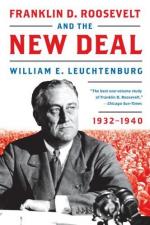
|
| Name: _________________________ | Period: ___________________ |
This test consists of 5 multiple choice questions, 5 short answer questions, and 10 short essay questions.
Multiple Choice Questions
1. The quote from Harold Clurman at the beginning of "Winter of Despair" states that people could smell what in the air during the winter of 1932-33?
(a) Starvation.
(b) Depression.
(c) Sulfur.
(d) Hope.
2. "Iron Age" reports during the summer of 1932 that steel plants are operating at what percent of their capacity?
(a) 12.
(b) 52.
(c) 98.
(d) 74.
3. In his attempt to adapt the Reconstruction Finance Corporation to the New Deal, Roosevelt puts a Texas banker in charge. What is that man's name?
(a) Harold Ickes.
(b) Jesse Jones.
(c) Ballinger Pinchot.
(d) Lewis Mumford.
4. By which of the following months in 1934 has Roosevelt grown tired of the new head of the Recovery Administration and secured that person's resignation?
(a) September.
(b) February.
(c) July.
(d) April.
5. In May of 1933, Roosevelt announces his choice to head the new Federal Emergency Relief Administration. Which of the following individuals does Roosevelt pick?
(a) Harry Hopkins.
(b) Robert Sherwood.
(c) Joseph E. Davis.
(d) Peggy Bacon.
Short Answer Questions
1. As "Waiting for Lefty" opens, in which of the following cities is City Hall attacked by a mob of 6 thousand people?
2. After founding his political organization, in which of the following states does Huey Long successfully rally a crowd of farmers in the spring of 1935?
3. In Roosevelt's speech at the beginning of "The Hundred Days' War" he states that the nation is not stricken by any plague of which of the following pests?
4. In "The Second Hundred Days" Leuchtenburg notes that because of the Rural Electrification Administration, for every 10 American farms how many have electricity by 1950?
5. Which of the following business executives laments in October of 1930 that the real blame for the financial crisis lay with the irresponsible--and now unemployed--populace?
Short Essay Questions
1. Explain how Roosevelt was finally able to collect enough delegates to make him the Democratic nominee for President in 1932.
2. Explain what can be considered ironic about the speeches of Roosevelt and Hoover during the 1932 Presidential campaign.
3. In "The Politics of Hard Times," why was the Republican party sure to lose the 1932 election?
4. Describe the nation's reaction to Roosevelt's first Fireside Chat on March 12, 1933.
5. Discuss and explain the disparity between supply and demand in 1932.
6. What happened in the 1934 Congressional elections, and why was the result surprising?
7. What was the labor problem anticipated during the 1930s, as discussed in "Winter of Despair"?
8. What can be considered ironic about the state of mind of jobless workers in 1934, as discussed in the opening of "One Third of a Nation"?
9. Discuss the ways in which the Social Security Act of 1935 represented a new way of thinking in American history, as detailed in "One Third of a Nation."
10. Explain the Old Age Revolving Pensions proposal put forth by Doctor Townsend, as discussed in "Waiting for Lefty."
|
This section contains 1,515 words (approx. 6 pages at 300 words per page) |

|




